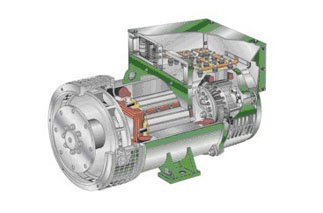
Analysis of rotation principle of ac generator
As the power generator of diesel generator, there are two kinds of commonly used alternators: three-phase asynchronous generator and single-phase alternator. The first is used in industry, and the second in civil appliances.The rotation principle of three-phase asynchronous generator
The precondition for a three-phase asynchronous generator to rotate is a rotating magnetic field. The stator winding of a three-phase asynchronous generator is used to generate rotating magnetic field. As we know, but that power facies phase difference is the voltage on the phase between 120 degrees, three of the three-phase asynchronous generator stator windings on the spatial orientation also sent 120 degrees, so, when during a stator winding into the three-phase power supply, the stator windings creates a rotating magnetic field, its process is shown in figure 1. In the figure, the process of rotating magnetic field is described in four moments. Every time the current changes, the rotating magnetic field rotates around the space, that is, the rotating speed of the rotating magnetic field is synchronous with the change of current. The rotation speed of the rotating magnetic field is: n=60f/P, where f is the power frequency, P is the magnetic pole logarithm of the magnetic field, and n is the number of revolutions per minute. According to this formula, we know that the speed of the generator is related to the number of magnetic poles and the frequency of the power supply. 2. Frequency conversion method. In the past, the first method was used, but now the variable frequency technology is used to realize the stepless variable speed control of alternator.
The rotation direction of rotating magnetic field is related to the phase sequence of current in the winding. Phase sequence arrange A, B, C clockwise, magnetic field, clockwise if any two of the three power cord switch root, such as current bubbled into C phase windings, B C phase current into the B phase winding, the phase sequence into: C, B, A, necessary counterclockwise in magnetic field. With this characteristic, we can change the rotation direction of the three-phase generator easily. Rotor stator windings creates a rotating magnetic field, after conducting bar (cage) will cut the lines of magnetic force of a rotating magnetic field and induced current, the current in the rotor conducting bar and interact with a rotating magnetic field to produce electromagnetic force, electromagnetic force produced by electromagnetic torque drive rotor rotating magnetic field along the direction of the n1 speed in the spin. In general, the actual speed of generator n1 is lower than that of rotating magnetic field n. Because assuming that n=n1, the rotor guide bar and rotating magnetic field will not move in a relative manner, and the magnetic force line will not be cut, and electromagnetic torque will not be generated. Therefore, the rotor speed n1 must be less than n. For this reason, we call three-phase generators as asynchronous generators.
The rotation principle of single-phase alternator
The single-phase alternator has only one winding and the rotor is squirrel cage type. When a single-phase sinusoidal current in the stator winding, the generator can produce an alternating magnetic field, the magnetic field strength and direction interplanting sine law of change at any time, but is fixed on the spatial orientation, say again so the magnetic field is alternation pulse magnetic field. This alternation pulse magnetic field can be decomposed into two at the same speed and direction of rotation are instead of a rotating magnetic field, when the rotor static, the two rotating magnetic field generated in the rotor torque of two equal and opposite, making synthetic torque is zero, so the generator to rotate. When we use external force to rotate the generator in a certain direction (such as clockwise rotation), the cutting magnetic line between the rotor and the rotating magnetic field in the clockwise direction decreases. The cutting magnetic field lines between the rotor and the rotating magnetic field in the counterclockwise direction move larger. The balance is thus broken, and the total electromagnetic torque produced by the rotor will no longer be zero, and the rotor will rotate in the driving direction.
To make single-phase generator can automatically rotate, we can add a starter in the stator winding, starting with the main windings in space by 90 degrees, starting winding to concatenate a suitable capacitance, makes differ with on the phase of the primary winding current approximate 90 degrees, the so-called split-phase principle. In this way, two electric currents with a difference of 90 degrees in time flow into two winding with a difference of 90 degrees in space, which will generate (two phases) rotating magnetic field in space, as shown in figure 2. Under the effect of the rotating magnetic field, the rotor can be automatic starting, after starting, to speed up certain, with the aid of an installed on the rotor of the centrifugal switch or other automatic control device will start winding disconnect, the only main winding work in normal working conditions. Therefore, the starting winding can be made into a short-time working mode. But there are a lot of time, starting winding is not broken, we call this kind of generator for capacitive single-phase generator, to change this kind of generator, can be achieved by changing the position of the capacitor is concatenated.
In single-phase generators, another method of generating rotating magnetic field is called the cover pole method, also known as the single-phase cover pole generator. The stator of this kind of generator is made of convex pole type, with two poles and four poles. Each pole in a third - quarter pole face open place with full of small tank, as shown in figure 3, the magnetic pole is divided into two parts, on the small part of the suit on a short circuit copper ring, like pole to cover up this part, so called cover pole type generator. The single-phase winding is set on the entire magnetic pole. The coil of each pole is connected in series. When connecting, the polarity generated must be arranged in order of N, S, N and S. When the stator winding current in the magnetic main flux, according to lenz's law, which through the short circuit copper ring main magnetic flux in the copper ring produces a 90 degrees on the phase lag of the induced current, flux on the phase of the current and lag behind the main magnetic flux, its role and capacitive starting winding of generator, so as to produce a rotating magnetic field generator turns up.
Principle of synchronous alternator
Synchronous generator is an ac motor, stator winding and asynchronous generator are the same. The speed of its rotor rotation is the same as that of the rotating magnetic field produced by the stator winding, so it is called synchronous generator. Because of this, the current of synchronous generator is ahead of the voltage in phase, that is, synchronous generator is a capacitive load. For this reason, in many cases, synchronous generators are used to improve the power factor of the power supply system.
Synchronous generators can be roughly divided into two types:
1. The rotor is excited by direct current
This kind of generator rotor is shown in figure 1, can be seen from the picture, it made salient pole rotor type, installed on the magnetic core field coil is in series, connect with alternation of opposite polarity, and there are two root wire connected to the two above the slip ring mounted on the shaft. Field coil is made by a small dc generator or battery to motivate, in most of the synchronous generator, direct current generator is mounted on the generator shaft, used to supply the rotor pole coil excitation current.
Since the synchronous generator cannot start automatically, the squirrel cage winding is also installed on the rotor to start the generator. The squirrel cage winding is placed around the rotor and the structure is similar to that of an asynchronous generator.
When the stator winding is connected to the three-phase ac power supply, a rotating magnetic field is generated in the generator. The squirrel cage winding cuts the magnetic force line and generates an induction current, which makes the generator rotate. Increased slowly after the generator, its speed to slightly lower than the speed of the rotating magnetic field, the magnetic coil rotor via direct current (dc) to inspire, to form a rotor magnetic pole, the pole is attempting to track on the stator rotating magnetic pole, thus increasing the rate of the generator rotor until synchronization with a rotating magnetic field rotation.
2. Synchronous motor with no need for excitation
The rotor unexcited synchronous generator can be applied to single-phase power supply and multi-phase power supply. In this kind of generator, there is a stator winding similar to the stator of the split-phase generator or polyphase generator, and there is a squirrel cage rotor, and the surface of the rotor is cut into a plane, as shown in figure 2. Therefore, it belongs to the salient pole rotor. The rotor magnetic pole is made of a kind of magnetized steel and can always remain magnetic. The squirrel cage winding is used to generate the starting torque, and when the generator rotates to a certain speed, the rotor salient is synchronized with the current frequency of the stator coil. The polarity of the salient pole is made up of stator induction, so it should be the number of the upper pole of the stator are equal in number, when the generator to its speed, squirrel cage winding is useless, keep rolling by the rotor and stator pole pole with live, synchronization. This type of generator is the commonly used types of generating units form a complete set of generators.

